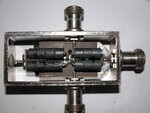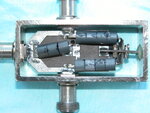anum_pirkani
Junior Member level 3
I am designing a 4 way wilkinson power divider but i am not getting the desired results.
I have to implement it wideband i.e 5GHz-15GHz.
After division into 4 parts, the S parameters have variations from the desired value and there is a difference between S21, S31, S41, S51.
Please help me out.
Each wilkinson network has N=3 and i have used 3 such two way wilkinson dividers.
I have attached the design and its output.
The design has been made in ADS.


I have to implement it wideband i.e 5GHz-15GHz.
After division into 4 parts, the S parameters have variations from the desired value and there is a difference between S21, S31, S41, S51.
Please help me out.
Each wilkinson network has N=3 and i have used 3 such two way wilkinson dividers.
I have attached the design and its output.
The design has been made in ADS.


